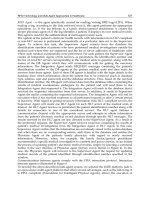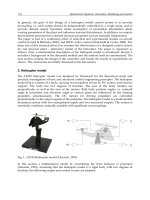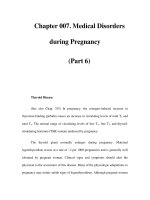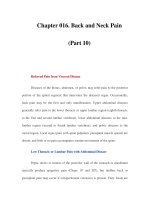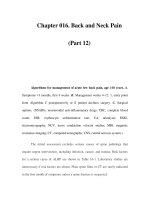Chapter 045. Azotemia and Urinary Abnormalities (Part 6) pdf
Bạn đang xem bản rút gọn của tài liệu. Xem và tải ngay bản đầy đủ của tài liệu tại đây (12.75 KB, 5 trang )
Chapter 045. Azotemia and
Urinary Abnormalities
(Part 6)
The normal glomerular endothelial cell forms a barrier composed of pores
of ~100 nm that hold back blood cells but offer little impediment to passage of
most proteins. The glomerular basement membrane traps most large proteins
(>100 kDa), while the foot processes of epithelial cells (podocytes) cover the
urinary side of the glomerular basement membrane and produce a series of narrow
channels (slit diaphragms) to normally allow molecular passage of small solutes
and water but not proteins. Some glomerular diseases, such as minimal change
disease, cause fusion of glomerular epithelial cell foot processes, resulting in
predominantly "selective" (Fig. 45-3) loss of albumin. Other glomerular diseases
can present with disruption of the basement membrane and slit diaphragms (e.g.,
by immune complex deposition), resulting in losses of albumin and other plasma
proteins. The fusion of foot processes causes increased pressure across the
capillary basement membrane, resulting in areas with larger pore sizes. The
combination of increased pressure and larger pores results in significant
proteinuria ("nonselective"; Fig. 45-3).
When the total daily excretion of protein is >3.5 g, there is often associated
hypoalbuminemia, hyperlipidemia, and edema (nephrotic syndrome; Fig. 45-3).
However, total daily urinary protein excretion >3.5 g can occur without the other
features of the nephrotic syndrome in a variety of other renal diseases (Fig. 45-3).
Plasma cell dyscrasias (multiple myeloma) can be associated with large amounts
of excreted light chains in the urine, which may not be detected by dipstick (which
detects mostly albumin). The light chains produced from these disorders are
filtered by the glomerulus and overwhelm the reabsorptive capacity of the
proximal tubule. A sulfosalicylic acid precipitate that is out of proportion to the
dipstick estimate is suggestive of light chains (Bence Jones protein), and light
chains typically redissolve upon warming of the precipitate. Renal failure from
these disorders occurs through a variety of mechanisms including tubule
obstruction (cast nephropathy) and light chain deposition.
Hypoalbuminemia in nephrotic syndrome occurs through excessive urinary
losses and increased proximal tubule catabolism of filtered albumin. Hepatic rates
of albumin synthesis are increased although not to levels sufficient to prevent
hypoalbuminemia. Edema forms from renal sodium retention and from reduced
plasma oncotic pressure, which favors fluid movement from capillaries to
interstitium. The mechanisms designed to correct the decrease in effective
intravascular volume contribute to edema formation in some patients. These
mechanisms include activation of the renin-angiotensin system, antidiuretic
hormone, and the sympathetic nervous system, all of which promote excessive
renal salt and water reabsorption.
The severity of edema correlates with the degree of hypoalbuminemia and
is modified by other factors such as heart disease or peripheral vascular disease.
The diminished plasma oncotic pressure and urinary losses of regulatory proteins
appear to stimulate hepatic lipoprotein synthesis. The resulting hyperlipidemia
results in lipid bodies (fatty casts, oval fat bodies) in the urine. Other proteins are
lost in the urine, leading to a variety of metabolic disturbances. These include
thyroxine-binding globulin, cholecalciferol-binding protein, transferrin, and metal-
binding proteins. A hypercoagulable state frequently accompanies severe
nephrotic syndrome due to urinary losses of antithrombin III, reduced serum levels
of proteins S and C, hyperfibrinogenemia, and enhanced platelet aggregation.
Some patients develop severe IgG deficiency with resulting defects in immunity.
Many diseases (some listed in Fig. 45-3) and drugs can cause the nephrotic
syndrome, and a complete list can be found in Chap. 277.
Hematuria, Pyuria, and Casts
Isolated hematuria without proteinuria, other cells, or casts is often
indicative of bleeding from the urinary tract. Normal red blood cell excretion is up
to 2 million RBCs per day. Hematuria is defined as two to five RBCs per high-
power field (HPF) and can be detected by dipstick. Common causes of isolated
hematuria include stones, neoplasms, tuberculosis, trauma, and prostatitis. Gross
hematuria with blood clots is almost never indicative of glomerular bleeding;
rather, it suggests a postrenal source in the urinary collecting system. Evaluation
of patients presenting with microscopic hematuria is outlined in Fig. 45-2. A
single urinalysis with hematuria is common and can result from menstruation,
viral illness, allergy, exercise, or mild trauma. Annual urinalysis of servicemen
over a 10-year period showed an incidence of 38%. However, persistent or
significant hematuria (>three RBCs/HPF on three urinalyses, or a single urinalysis
with >100 RBCs, or gross hematuria) identified significant renal or urologic
lesions in 9.1%. Even patients who are chronically anticoagulated should be
investigated as outlined in Fig. 45-2. The suspicion for urogenital neoplasms in
patients with isolated painless hematuria (nondysmorphic RBCs) increases with
age. Neoplasms are rare in the pediatric population, and isolated hematuria is more
likely to be "idiopathic" or associated with a congenital anomaly. Hematuria with
pyuria and bacteriuria is typical of infection and should be treated with antibiotics
after appropriate cultures. Acute cystitis or urethritis in women can cause gross
hematuria. Hypercalciuria and hyperuricosuria are also risk factors for
unexplained isolated hematuria in both children and adults. In some of these
patients (50–60%), reducing calcium and uric acid excretion through dietary
interventions can eliminate the microscopic hematuria.
